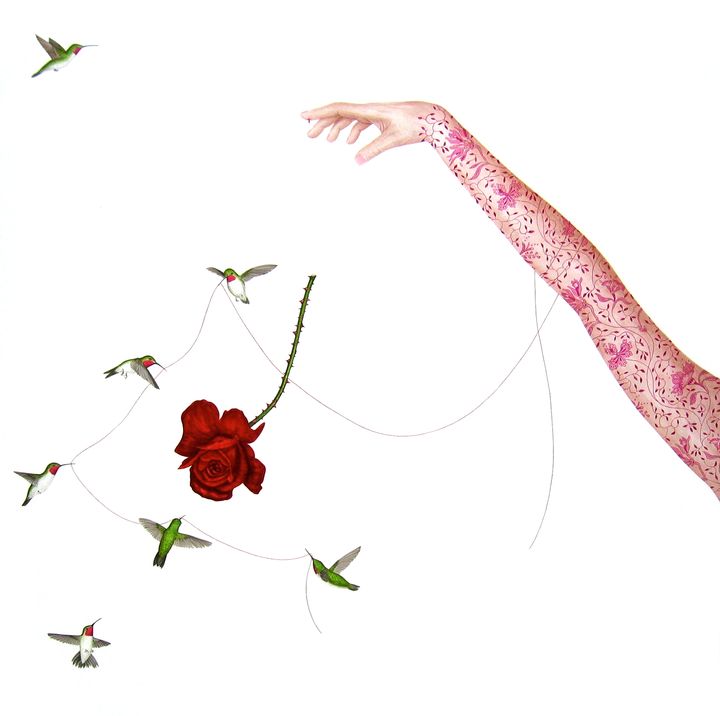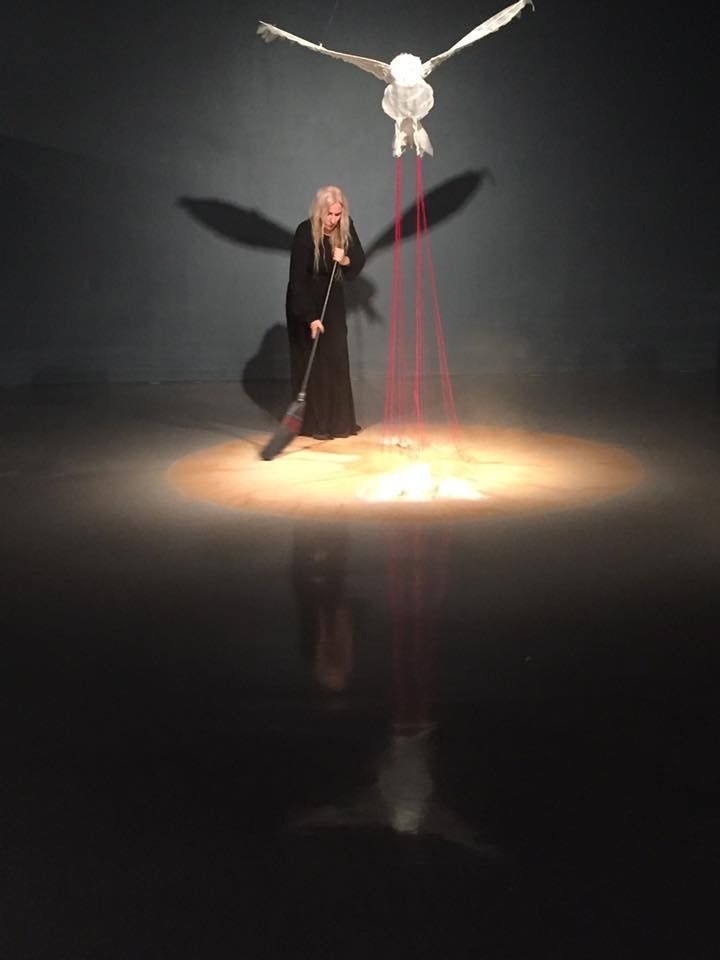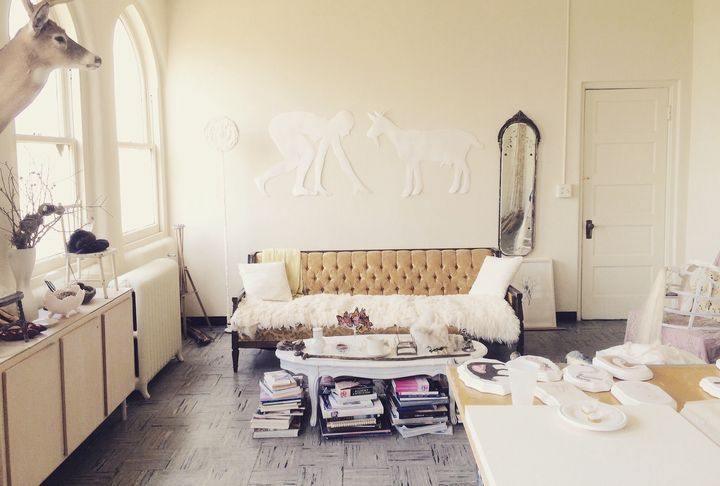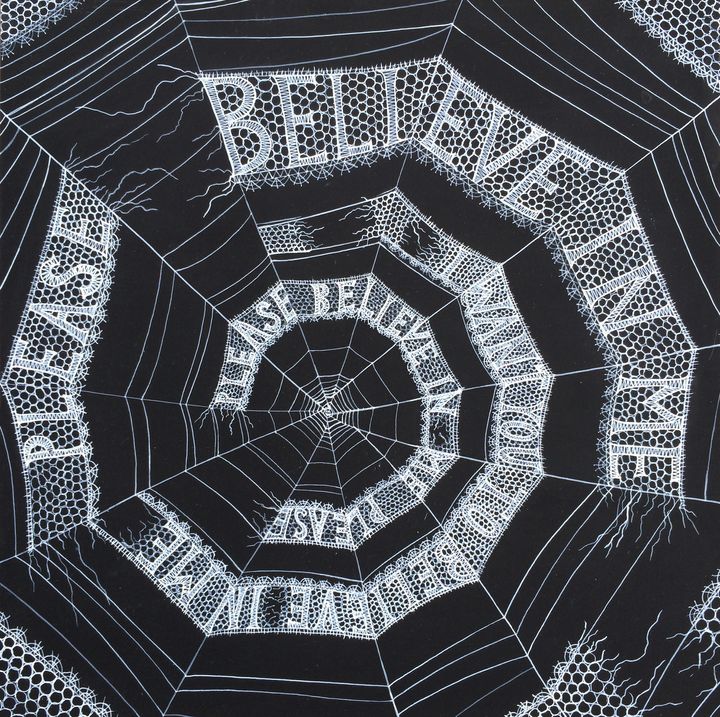Susan Jamison is a Roanoke, Virginia based artist who specializes in feminist, natural paintings, using egg tempera. That is certainly a simplistic explanation of all she creates. Her paintings draw me in and make me think about other-worldly ideals. Susan will be giving a presentation on how she develops her imagery at FOCUS Contemporary Art in Scottsville, Virginia on Saturday, February 18, 2017 at 6:00 pm. She was kind enough to take some time to answer these questions:
One night, I recently dreamed I met Alvin “Seeco” Patterson, the percussion player from The Wailers, and we discussed the conga part in “No Woman, No Cry,” where he played a single eighth-note roll just one time, after the first set of lyrics. It happens only that one time in the song, and to me, it makes the song. There are a few other songs in music where something like this occurs (Pink Floyd’s “Run Like Hell” comes to mind)...I’ve gotten to the point where I’m dreaming about this stuff and it makes me wonder: are there certain technical aspects about art that you obsess over for a time until you understand the depths of it...the why behind the how? What makes an artist do what they do in the moment?
It’s an interesting choice for you to open your questions to such a femme artist with thoughts about iconic male musicians! Lately the soundtrack of my life has been almost exclusively female and I’ve been revisiting the music of artists I listened to in my college days such as Kate Bush and Elizabeth Fraser who are also technically proficient and detail oriented. I do tend to listen on repeat until I understand the nuances. When I was in graduate school at RISD a professor I worked with noticed these qualities in me and she suggested that I take a class called Renaissance Painting techniques as an elective. This is where I learned to make and use egg tempera paint. After years of mixing and applying this tricky dry pigment and egg yolk emulsion this work comes as naturally to me as brushing my teeth so I no longer obsess over the technical aspects of it. It’s only when I’m teaching a workshop that I remember how difficult it is. I do think a lot about how my technique of choice engages with the content of my imagery. An egg yolk is the feminine stuff of life and my paintings depict that. Now I am starting to make sculptural forms and installation projects and I do obsess over every last detail both visually and intellectually. Having said all that, what makes me do what I do in the moment is my desire to manifest the visions I see in my mind into material reality. I honestly do have visions of all the work I make before I make it.
I love Kate Bush. You have mentioned you learned the ways of the natural world (and dare I say the supernatural) from your mother. I am lucky enough to have a good witch for a neighbor, and I’ve gotten to travel to Costa Rica with a shaman. What are your thoughts on witches and shamans?
I had an unusual childhood. My family had a large expanse of heavily forested wild land in the southern part of Indiana near Kentucky where we would go and live like the wilderness family on weekends and in the summers with no electricity or running water. This is where my mother taught me about the wildflowers, spiders, birds, snakes, and foxes that I paint. She taught me to respect and protect nature. Even as a child, I found my higher power in the woods and I could feel the energy of a tree or the moss underneath me. I think of witches and shamans as people who connect with the natural and the spirit world and can use their knowledge for healing or to transform something. They are perhaps people who know how to harness and direct energies or who understand quantum physics. There are all kinds of ways people self define their magickal practices and for some it is a religion. I think we are now seeing a lot of younger women looking for a connection with the divine feminine and this yearning is leading them to an interest in witchcraft and magick. They want to learn the knowledge that women who were the herbalists, healers, and midwives knew. They want to embrace the power of feminine energy.

“Repair Me”
Your art strikes me as compellingly unsettling. In the best possible way. It conjures a sense of magical realism. I totally believe the scene in “Repair Me.” It is not at all far fetched. Will you please explain what you are getting at with your subject matter? I find it fascinating, but I do not want to enter into the world of art criticism. I would rather you just tell me.
I love what you said, compellingly unsettling! I really do try to balance beauty and repulsion in my images. Oh pretty, come here, no, ew gross, look away! My paintings are allegorical. My subject matter is birthed from my own life experiences, my visions, and a desire to create images that the viewer can see themselves in and then are intrigued enough to decipher. I love that even a child will walk up to one of my paintings and say, “snake!” That snake is an entry point for them. From a feminist perspective I do think a lot about the natural world and its connection to the feminine. There is a book called The Death of Nature, by Carolyn Merchant, which discusses how a mechanized society exploits nature and creates a societal order that subordinates women. It is easy to see this debate between industry and the natural world still raging in the news today. We are killing mother nature. Depicting my connection to her is personal, political, spiritual, and feminist for me. There is also a rebellious bad-girl part of me that wants to paint things that are flowery, pink, and girly. I embrace my feminine otherness and I look to woman as my artist role models including the ones who were embroidering samplers or making lace. I’m currently creating an installation titled “Sanctuary for the Crone,” and I will be doing some embroidery on silk organza for that project, which is about creating a special space for the invisible older women to sit and express their life’s wisdom. I’m sure this will be compelling and unsettling to some but mostly I hope it will be affirming.
I am not a fan of most critical writing. A friend of mine told me he once took a class on literary criticism in graduate school and never once read anything from a primary source. I can imagine how dull that class must have been. However, some critics just get it. Pam Grossman’s essay about your work is a good example: she discusses the dichotomy of your art. Surrender and agency; exposure and ornamentation; vulnerability and strength. “She straddles extremes, balancing opposites with grace and composure as she undergoes her own magical development.” Thoughts?
I read a lot of critical theory in my grad school seminars and I noticed that much of it is very circular. It’s writing about itself, it eats itself, or combats itself, and then it regurgitates itself. Some of the other students tried to decipher it as if it was the rosetta stone to their artmaking practice and the key to future fame which is a major failing. To me it was an important part of my education to read it, understand it, then move past it. I think there is a difference between this circular critical theory, or even old school ego forward art criticism, and the kind of contemporary art writing you might find on a site like Hyperallergic which engages and informs me. These writers seem to have a love of art and artists and a desire to share with the viewer. They embrace otherness and I’ve learned quite a lot reading their viewpoints. Ms. Grossman’s essay on my work was written for a catalog that was produced for my recent exhibition “Super Natural.” It’s really less of a critical viewpoint and more written with the purpose of adding her articulate insights to enlighten people about my work. I actually cried when I read what she wrote about my work because she had connected with it so deeply and she was able to articulate ideas that even I couldn’t. Her website, www.phantasmaphile.com focuses on esoteric and fantastical art. I always try to keep up with her writing and the work she features. She expresses her love of and excitement about art. I think the notion of the singular cantankerous old man art critic is dated and no longer very relevant when we have so many great sources to go to for informative art writing.

“Sweeping Up”
What is your creative process? Do you rely on the Muses, or routine, or some combination of both? Sometimes, if I get struck with inspiration, I just have to create right then and there, no matter the time, no matter the place. Sometimes you have to manufacture inspiration. How do you see it?
I rely on the Muses, as in the visions that appear in my mind, but I also rely very heavily on my routine and my studio practice. I work both in my studio which is separate from my home and my large dining room table in my living space. It’s important for me to be in one of my art making places in order to focus on my work. The physical work of painting is relatively sedentary and tedious for me. It hurts my back and strains my eyes but it is strangely satisfying. The idea that an artist is suddenly struck with inspiration then just sits around happily painting while sipping Cabernet is a lovely fantasy. The job of an artist is really involved with looking, reading, thinking, editing, making, writing, and communicating. I do most of these things every day.
Why are you creative?
I think everyone is creative in some way. Perhaps I have the gift to be able to express my creative nature visually and the fearlessness to keep doing it.
Some of your paintings remind me of Peter Gabriel’s record, “Us.” Just in a sense. I hear him struggle with emotion, masculinity and femininity, the natural world...digging in the dirt. Do other art forms inspire you? Is there any art form that inspires you more than any other? Or nothing?
I think people who embody that balance of masculine and feminine aspects are the most interesting and complex folks to spend time with so I will take your comparison as a huge compliment. I haven’t heard that album in years. I will have to listen to it again today. A man I met at one of my recent exhibitions told me that he viewed the female figure inside of the bear in my “Power Bear” painting as his female aspect that he carried inside. I love his reading of that painting. I did not see that coming. Music inspires me, visual art inspires me, culinary art inspires me, writing inspires me. I don’t see a hierarchy to creative expression. It’s all important and necessary.
Please describe a day in your studio. Is there a certain amount of chaos, or is it mostly a controlled endeavor? Do you listen to music when you paint?
In the morning before I get out of bed I make a plan for my day in my head. I like to work during typical work hours like a nine to fiver. I keep a printed out calendar with dates and goals of events I need to prepare for taped to the side of my refrigerator. I dislike chaos and disorganization. They are the enemies of productivity and clear thinking for me. Monday is cleaning day and I take care of any mess I made the previous week so I have a fresh start. My studio is very bright and relatively tidy. I know where everything is. I’m not a paint thrower. Keeping the backgrounds of my paintings solid white or charcoal black isn’t easy and it requires attention to cleanliness. Now I have yards and yards of white silk organza hanging around too and that has to be kept clean. I never ever work without music playing. I usually listen to something that is very heavily rhythmic to keep me going. Female musicians are always on heavy rotation. My current musical obsession is Juana Molina.

Jamison’s studio
I draw a lot of parallels between art forms, especially between cooking and playing music. Do you like to cook? What is your favorite recipe? Please tell me your favorite memories involving the kitchen, cooking, and food.
You uncovered my big secret, I love to cook! I find it very relaxing, probably because I don’t do it professionally. I’ve been cooking for many years, so I no longer follow recipes unless I’m baking or trying something new. I do make a version of shrimp and grits that I think is pretty tasty. I have spectacular memories of my childhood catching fish and cooking them over an open fire when we were in our wilderness family years. When I was in the fifth grade we moved to the suburbs of DC in northern Virginia and my mom’s sister in Connecticut got her a subscription to Southern Living Magazine kind of as a joke. I really liked all the pictures of food in this publication and I asked my mom if we could eat some of that stuff. She said, “Make a grocery list of what you need. You can make anything you want.” I made seafood crepes with Newburg sauce. Ha ha! What kind of kid does this?
Your tiny paintings feature studies from some of your larger pieces. These are some of my favorites. I love the two headed snake and the snake eating the frog. What is the story behind those?
The small works on craft plaques were a way for me to offer paintings that are affordable to people like me who have smaller budgets. I like the idea of painting on wooden plaques that are readily available at craft stores that ladies use for decoupage or tole painting. I prime them with traditional style gesso that I cook up with animal hide glue and marble powder so they actually are more labor intensive than what they appear to be.
Pam Grossman writes deftly about your use of egg tempera. What do you think about all the depth and heaviness that brings to your work? You bear a lot of responsibility painting with a medium so charged with life.
Since I mix my own paint from dry pigments, water, and egg yolk for every painting session it does become part of that magickal process of bringing up an image layer by layer from a stark white panel. As I touched on this in an earlier question you asked about the technical aspects of my work, I do feel the weight of egg tempera as a medium and I think the materials are appropriate for the content of my work. I recently made a painting of a mother nature figure, “Love Inside and Out” that is an homage to a painting of Venus by Botticelli who is perhaps the best known painter who used egg tempera. Oddly enough his Venus is now on view at the Muscarelle Museum of Art in Virginia. I feel certain I compelled it to come to my home state (wink.) As a side note, I also want to mention that I do pay extra for free range chicken eggs to make my paint.
Some art is beautiful just to be beautiful. Fine art...art for art’s sake. Some art makes people uncomfortable. Some art is political in nature. What do you think art’s job is...its ultimate purpose? And what responsibility does the artist hold to the audience, if any at all? I can think of hundreds of examples of this, but I want to hear what you think...and please give examples of your favorites.
Now we are getting into the fields of philosophy and aesthetics. Those are big questions and by answering them concretely we risk creating boxes that artists have to stay in. Artists dislike these boxes and we will always find a way to pop out of them. As a viewer I seek a wide range of experience. One of the most uncomfortable artworks I can think of is Chris Burden’s “Shoot,” the performance where his assistant shoots him in the arm. Yoko Ono’s Cut Piece is very disconcerting and moving to watch. Sonia Clark’s Unravelling of the Confederate flag is profoundly political and personal. Vija Celmins paintings of water, or the starry sky, are meditative and just full on beautiful. Louise Bourgeois was a master at visually manifesting her trauma in a very relatable way. Personally I feel the desire to express and communicate through what I make and I’m not sure if it’s useful to state what my art’s job is beyond that because I don’t care to be confined. My work’s purpose may change with the next project. I feel a big responsibility to create entry points in my work for my audience. One person might only be able to identify a bird in one of my paintings, like a goldfinch having seen one in their yard and another person might know that the goldfinch is a traditional symbol of resurrection from studying art history. Either way that bird is something they connect with that draws them in. Now I’m starting to make pieces like “Sanctuary for the Crone” that will be interactive with my audience. All the wise and lovely crones who come to my next exhibition opening in April at Chroma Projects will complete the work.
The spider webs. There is a longing there...a for more life and sex and love and hope. Please tell me about them.
My spider web paintings are an homage to my favorite book from childhood, Charlotte’s Web. I was pondering what the spider Charlotte would want to communicate to, or for, the adult Fern? These works have lacy text woven into the spiderweb. They say things like “See me, why don’t you see me?” and “Touch me, why don’t you touch me?” My favorite one says “Believe in me, please believe in me,” and the title is “Note to Self.” Perhaps these works are my daily affirmations.

“Note to Self”
Finally, can you give us an idea of what you will be discussing at FOCUS on Saturday?
I will be discussing the development of my painting imagery through a slideshow presentation featuring older work, images that influenced me, and newer paintings. I will have a few paintings and some small drawings on display in the gallery. I will likely tell a few stories about my wildchild times that I spent running through the woods. Audience questions will be most welcome.